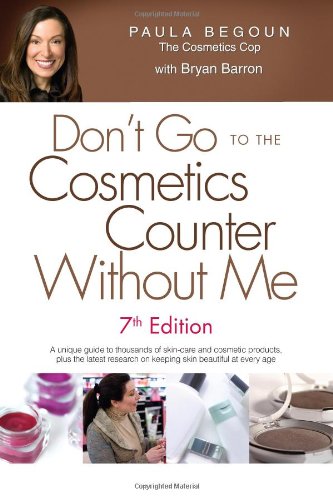Being an informed shopper can go a long way toward saving money. With that in mind, I’d like to dispel some little-known facts about hair care products that I learned from reading Don’t Go Shopping for Hair-Care Products Without Me by self-proclaimed “Cosmetics Cop” Paula Begoun. It not only covers some of the myths surrounding hair products but also provides some helpful tips.
Hair Product Tips and Myths
Begoun is well-known for her extensive, ongoing research and testing of hair and beauty products. She publishes her findings every couple of years in her series of books on the topic.
Don’t Go to the Cosmetics Counter Without Me

In this book, Begoun teaches readers how to shop for beauty products that are inexpensive and provide desired results. Buy the 7th Edition for $21.79 at Amazon now.
In her other book, Don’t Go Shopping for Hair-Care Products Without Me, Begoun reviews over 4,000 hair care products for your benefit. Get it now for $39.98 at Amazon.
Begoun’s primary goal is to provide honest, unbiased information so that consumers can find out what really works and avoid everything else. Here are 10 things I learned from her that will help you save money on your next shopping trip and for years to come.
1. Hair Salon Dye Is Better Than Boxed Dye
There is no difference in the quality of the hair dye that you buy in a box at the drugstore for $10 and the hair dye used in salons. If you’re making a subtle change (like going from medium brown to dark brown) or you’re rather skilled with hair dye, there’s no reason not to do it yourself at home, especially if you’re dyeing your hair every few weeks. Doing it yourself can save you $50 a month or more. If you’re making a drastic change, however, the extra knowledge and experience of a professional can help you get better results and be worth the extra cash.
Personally, I’ve had just as many hair dying successes as I have disasters, but the successes were with minor changes and the disasters with major changes. Professionals can mess up your hair too, of course, but they’ll probably fix it for free if they do.
2. Hair Products Preserve Color
Now that you’ve found that perfect new shade, be aware that shampoos and conditioners can’t preserve your hair color — so don’t waste your money on products that make this claim. Dandruff shampoos can strip hair color, however, so if you’re having dandruff problems, hold off on that dye job until you’ve cured the problem.
3. Hair Stylists Are Product Experts

Many hairstylists’ product knowledge comes straight from the product manufacturers, making stylists a less reliable source of advice than most people assume. This doesn’t mean that they can’t do a better job with cutting, styling, dyeing, and highlighting than you can. It means that when you’re looking for a product recommendation, you should take a stylist’s advice with a grain of salt before spending extra money on expensive salon products.
4. Expensive Hair Products Better Than Cheap Ones
Your hair can’t tell how much your shampoo costs — expensive hair care products are no more effective than inexpensive ones. In fact, many expensive products are actually produced by the same companies that make the inexpensive ones and contain virtually the same ingredients. You might be pleasantly surprised with the results of a 99 cent shampoo if you’re willing to give it a shot. I have to admit that even though I know this, I’m a sucker for the scents of expensive shampoos — so I compromise and buy the $4 stuff.
5. There is An Endless Variety of Shampoo and Conditioner
There aren’t really as many kinds of shampoo and conditioner as their labels suggest. Remember when there used to only be three kinds of shampoo? One for fine/oily hair, one for normal hair, and one for dry, damaged, or color treated hair? Nowadays, it seems like most brands have anywhere from six to sixteen different varieties promising to do everything from getting your hair really clean to enhancing curls.
The truth is that these products, despite their differing claims, tend to have nearly identical formulas that will provide nearly identical results. Strategic labeling does get people to buy more products, though, by promising to solve different hair dilemmas (the same person often has multiple hair issues, after all) and by taking up more shelf space (thus doing a better job of in-store advertising for a particular line).
Hair product ingredients must be accurately labeled according to FDA standards (here), but there are no regulations on the accuracy of product claims. Hair product companies can say that a product does whatever they want. This includes claims such as “hypoallergenic” or “all natural.” Don’t spend more money on a hair product that makes amazing claims. Hair companies operate in a mostly unregulated market, so it’s quite possible that they aren’t true at all.
6. Everyones One’s Hair is Oily
There is no such thing as an oily hair type. It is the scalp that is oily. When oil makes its way down the hair shaft (which it does particularly well on straight hair), the hair appears oily. Unfortunately, no product can decrease your scalp’s oil production. There really isn’t a lot you can do to remedy this problem aside from washing hair frequently and keeping conditioner away from the scalp (or avoiding conditioner altogether if you can). Don’t waste your money on expensive products that claim they can fix your oily hair — hormones control oil production, not shampoos.
7. You Can Repair Damaged Hair
Damaged hair cannot be repaired because hair is dead, so don’t spend money on expensive products that claim to repair your hair. Begoun likens trying to repair damaged hair to trying to mend a dry, cracked leaf. It won’t happen! Conditioners can give hair the appearance and feel of being repaired, but this will only last for as long as the product is in the hair (until the next shampoo). If you’re using the same deep conditioner every day, you may feel like your hair has been repaired. But if you buy expensive, one-time deep conditioning treatments, the results will only last until your next shampoo — and that’s money down the drain, literally.
8. Volumizing Shampoos Actually Work
Used regularly, volumizing shampoos will eventually weigh down your hair and make it even limper than it was to start with. The same ingredients in these products that coat each hair strand to make it appear thicker also build up on the hair over time. If you use a volumizing shampoo, make sure to alternate it with a regular shampoo. If you’re trying to save money, you may just want to skip the volumizing shampoo altogether. Personally, I don’t think volumizing shampoos help at all.
9. Natural and Organic Products Are Better for Your Hair
All-natural or organic shampoos may be better for the environment, but they are not necessarily better for your hair. Natural products often contain irritating ingredients like citrus or peppermint. (If these ingredients don’t give you any trouble, use them, but they can be irritating for some people). If your primary goal is to find a product that is gentler on your hair or scalp, don’t waste your money on these products.
10. Hair Growth Products Effective On Both Genders
While hair loss is more prevalent in men than in women, hair regrowth products are, unfortunately, significantly more effective on women. If you’re following the directions and you’re not getting results, you can stop spending $50 a box because these products won’t work on everyone and may be especially less likely to work if you’re male.
The baffling variety of haircare products available these days can make trying to pick the right bottle a dizzying experience. Hopefully, these facts will help guide you in your hair care shopping, prevent you from needlessly wasting money, and eliminate frustration. For more hair care product advice for every hair type and hair problem, be sure to check out Paula Begoun’s Don’t Go Shopping for Hair-Care Products Without Me.
Do you have any other hair product tips that help save money? Share with us in the comments below!
Read More:
- How to Save Money on Hair Care
- Can You Make Money Selling Your Hair?
- 22 Things You Should Never Flush Down the Toilet
Read the full article here
















